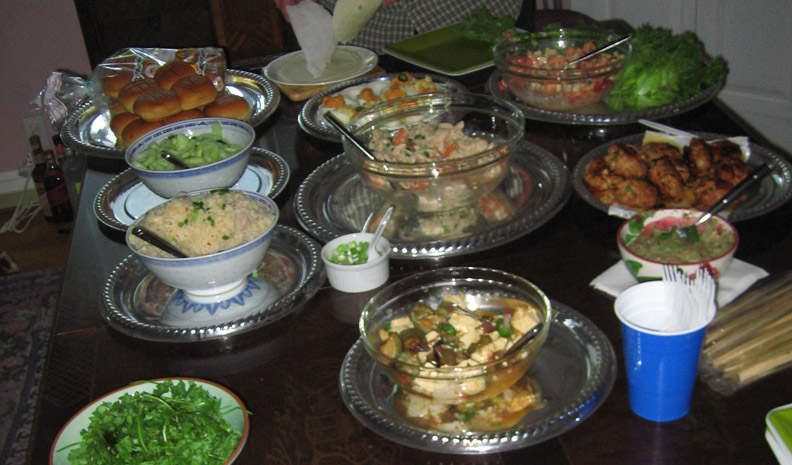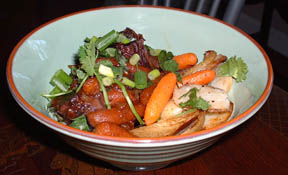 When my hubby and I go to our favorite Korean restaurant for their buffet, it seems that I am never offered any kalbi. Neal can bring back platesful, but nobody asks me if I would like some. So I decided to make some of my own. Or a variation thereof.
When my hubby and I go to our favorite Korean restaurant for their buffet, it seems that I am never offered any kalbi. Neal can bring back platesful, but nobody asks me if I would like some. So I decided to make some of my own. Or a variation thereof.David Chang, of Momofuku Noodle Bar, in Manhattan, has been featured in the Times on a regular basis these past few weeks. Earlier in the month, I found his recipe for what seemed like a cross between kalbi, and nikujaga--a Japanese potato and beef stew. We've been having blissfully cool Spring weather, so I decided to have one more hearty food feast before it starts getting unbearably hot here in Baltimore.
I don't think I've ever used so many pots, pans, utensils, and plates in cooking a single meal before. I needed the Dutch oven (1) to brown the meat; because I did so in two batches, I also needed a large bowl (2). The meat then went into a large glass casserole (3) that was placed on a cookie sheet (4), for stability. The cooking liquid was prepared in a non-stick saucepan (5). After four hours in the oven, the meat went into another large bowl (6), and the cooking liquid went back into the already washed non-stick saucepan (7) to be reduced. The meat and reduced liquid met again in a large saute pan (8) with lid (9). The potatoes and carrots went into a square baking dish (10), and into the oven, since it was already heated and I wasn't in the mood to saute them. The green onion garnish went into a small bowl (11) but the cilantro was left on a paper towel. Tongs (12), various spoons (13-15), and a bowl to collect the oodles of grease floating on top of the sauce (16), were also employed, not to mention the salad plates, dinner bowls, and wine glasses for the rest of the meal. Whew! A lot of washing up!
But it was worth it. The sauce was rich and sweet and garlicky, and the meat was spoon-tender. Definitely restaurant-quality flavor. I especially enjoyed the contrast between the carrots that were cooked with the meat and sauce, and the ones I oven roasted with the sliced potatoes.
Braised Short Ribs
Adapted from David Chang
Originally Published in the New York Times, April 5, 2006
1½ cups pear or apple juice
1 cup sake
1 cup mirin
½ cup sugar
1 cup soy sauce
Salt and freshly ground black pepper
2 tablespoons chopped garlic
10 cloves crushed garlic
1 tablespoon sesame oil
2 tablespoons neutral oil, like corn or grapeseed
4 to 5 pounds short ribs
2 large onions, peeled and roughly chopped
1 pound carrots, peeled and cut into chunks
2 tablespoons butter
8 to 12 small potatoes, preferably fingerlings, trimmed
½ cup chopped scallions
4 cups cooked white rice.
1. Preheat oven to 350 degrees. In a saucepan, combine juice, sake, mirin, sugar, soy sauce, about 20 grinds of pepper, both forms of garlic, sesame oil and 1½ cups water. Bring to a boil, then simmer.
2. Put corn or grapeseed oil in a large ovenproof braising pan or skillet over medium-high heat and add ribs, seasoning them liberally with salt and pepper. Brown well on one side, moving them around to promote even browning. Turn, add onions and half the carrots, and brown other side, stirring vegetables occasionally.
3. Carefully pour braising liquid over meat and bake, bone-side up and submerged in liquid (add water or juice if necessary), for 3 to 4 hours, until meat falls from bones. Cool ribs in liquid for 1 hour, then remove; strain liquid. At this point, ribs and liquid can be covered and refrigerated overnight.
4. Remove bones from ribs. In a pot, combine meat with braising liquid; heat to a boil then simmer, reducing liquid until syrupy. If it seems too thick, thin with a bit of water.
5. About ½ hour before you are ready to serve, put butter in a skillet and add potatoes and remaining carrots. Cook, stirring occasionally and seasoning with salt and pepper, until browned and nearly tender, about 20 minutes. Add to meat. Taste mixture and adjust seasonings if necessary, then garnish with scallions and serve on rice.
Yield: 4 to 6 servings.

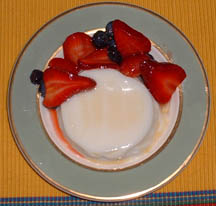 I love custard in all its forms - creme brulee, creme anglaise, flan, quiche. Custards are liquids that have been set or thickened by the coagulation of egg proteins. But there are other desserts that are quite creamy and rich and very custard-like...but that contain no eggs. Blancmange is one, and Panna Cotta is another.
I love custard in all its forms - creme brulee, creme anglaise, flan, quiche. Custards are liquids that have been set or thickened by the coagulation of egg proteins. But there are other desserts that are quite creamy and rich and very custard-like...but that contain no eggs. Blancmange is one, and Panna Cotta is another.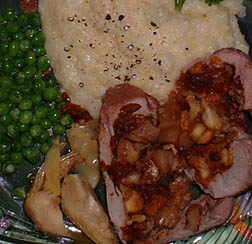 When you hears the word "stuffing," you usually thinks of Thanksgiving turkey, right? But as long as you have a starch, a fat, and seasonings, you can make stuffing.
When you hears the word "stuffing," you usually thinks of Thanksgiving turkey, right? But as long as you have a starch, a fat, and seasonings, you can make stuffing.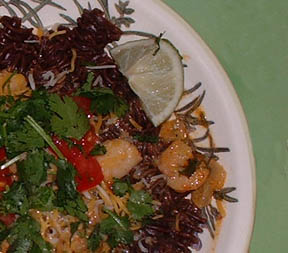 Ever have
Ever have 